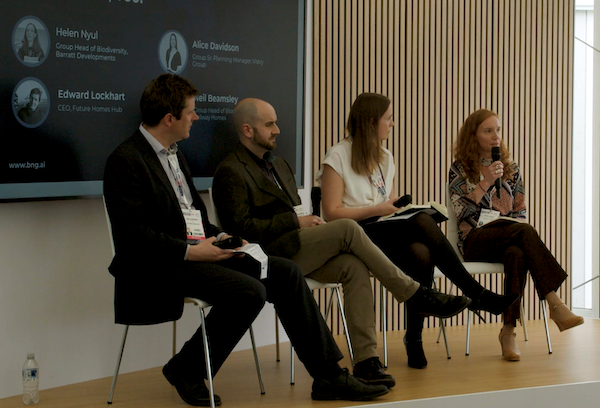- Blogs
- How 3 top UK developers are meeting biodiversity net gain planning requirements: UKREiiF 2024
What are the best BNG planning practices? How can you align BNG plans with local conservation efforts? What role does technology play in your efforts?
Three of the UK’s leading developers tackled these questions and more in a panel discussion at UKREiiF 2024. The panel was sponsored by AiDash and hosted by Edward Lockhart, CEO of Future Homes Hub, and speakers included:
- Helen Nyul, Group Head of Biodiversity, Barratt Developments
- Alice Davidson, Group Sr. Planning Manager, Vistry Group
- Neil Beamsley, Group Head of Biodiversity, Bellway Homes
Read on for key takeaways from the session.
Approach BNG planning with positivity
The panel offered practical advice for taking a multifaceted approach to the obligations and possibilities of biodiversity net gain planning—inside and outside of development projects.
“We deliver BNG on-site, wherever we can,” explained Vistry Group’s Alice. “We are [continually] looking at off-site strategic solutions and looking for nature authorities to partner with.”
Helen, from Barratt Developments, said her organization is very supportive of the 10% BNG requirement. “That journey has helped us to understand the pros and cons of trying to deliver [BNG] all on site and where we look to invest in more strategic areas of conservation through off-site delivery as well,” she said. “So, there’s a plethora of ways we can come at BNG.”
“We’ve tried to instill a feeling of positivity around BNG—trying to emphasize that it’s not an insurmountable problem,” explained Bellway Homes’ Neil. “We can find solutions and make sure that it’s instilled in the way we take things forward.”
Plan to fit—not retrofit—BNG into your development
The panel advised that developers gain an understanding of their baseline before proceeding with BNG planning.
Helen explained that you can’t follow mitigation hierarchy for biodiversity loss (avoidance of loss, minimization of loss, restoration of areas, offsetting loss on-site or offsite) if you don’t first understand your baseline. Alice added that from a planning perspective, “having that baseline understanding early on is important, as local planning authorities will want to know whether you will be delivering BNG on-site or off-site.”
The bottom line? Determine your baseline and plan early, because, as Neil explained, “If you try to retrofit BNG, it can become very, very problematic very, very quickly.”
Tech will be essential to move BNG forward
With the amount of data that BNG planners must consider throughout the full 30-year process, adding technological advances to the BNG process is a must.
The panel agreed that supporting the process with technology, such as the satellite- and AI-powered AiDash BNGAI™ platform that Barratt and Vistry have experienced, is an essential component of building the big BNG picture.
Alice said that an area in which AiDash technology has aided Vistry Group is in taking an initial look at the site to see if it’s viable for development without sending people in for a full ground evaluation, as well as early assessment of habitat in the BNG planning process. “[It’s] just really helpful to understand … before you’ve perhaps even visited the site, where you are with your baseline and what you’re going to need to consider at the next stage,” she explained.
But, as each panel member’s companies have all experienced, human understanding of tech contributions and the human component are just as vital.
“I think the thing to remember also about tech—and especially the offering that AiDash is giving—is that the tech has to be supported by people as well,” said Helen. “It’s not a solution in and of itself. There is other input that needs to happen to make it a fully rounded a service.”
Neil agreed that more input is required: “A little bit of interpretation as well a bit of internal training—a little bit of dialogue—really goes a long way to help smooth out the bumps in the road.”
Plan early and often to make it easy for your local authorities
The panel agreed that early engagement and clear planning is the best way ensure a straightforward, streamlined BNG approval process with local planning authorities (LPAs).
“I think from our point of view, it’s about making the job of the local authorities as easy as possible,” said Neil. “There will always be situations where there’s a little bit of interpretation and discussion and back and forth and disagreement, but actually if the fundamental assessment from a BNG point of view is correct in the first place, that makes things much easier,” he explained.
Alice recommended that from a planning perspective, developers should engage with local authorities at a very early stage of both on-site and off-site BNG planning. “[It] seems to really help if you bring them in at that earliest point, before you’ve made too many moves in terms of your approach,” she said.
Barratt Development’s approach, as Helen noted, is much the same: “Being as open and transparent and engaging as early as possible.”
Set best practices for on-site BNG and add forward-thinking initiatives
Barratt Developments makes it a point to add initiatives to BNG planning, since they all contribute to the BNG “score,” according to Helen. An example is building sustainable urban drainage systems and rain gardens into public open spaces. This contributes to the BNG score while addressing requirements for public open space amenity.
On the innovation front, Helen added: “I think there’s a lot to be explored in terms of the wider impacts on biodiversity through our supply chains—whether there are any potential ways of reducing impacts throughout through that supply chain by reusing materials.”
Neil offered a best practice of being pragmatic about the BNG plan that you produce using the Defra Statutory Biodiversity Metric. While the metric may show that you probably can get to 10% within your site, Neil advised that you pause to consider whether you can actually deliver that 10%. Is it practical? If not, a relook at the plan through the metric may be needed, he said.
“I think it’s also important to consider the [BNG plan] management and maintenance,” Alice added. In some cases, it might be best practice … to hand the management to local authorities. She explained that Vistry works with local authorities when developments have open space within their BNG plans to see where authorities might be able to take on its management.
Due diligence is needed to secure appropriate off-site BNG
Securing BNG units off-site presents its own challenges, whether a developer cultivates them on their own additional sites or purchases them from a third party.
Neil explained that planning ahead is helpful in securing off-site BNG units. He noted that Future Homes Hub offers a Biodiversity Unit Finder on their website to connect developers with opportunities to purchase BNG units. Also, he added, “I think it’s about building relationships with the right people. Start that conversation early, rather than waiting until you get planning.”
Helen pointed out that as Local Nature Recovery Strategies (LNRS) are put in place, “it’s going to hopefully make identifying where those offsets are a lot easier.”
Alice seconded the early planning for use of offsite BNG, as cost and availability of BNG units will vary by provider and location. Research into sources is necessary.
She also noted that Vistry is considering the potential to effectively bank excess BNG units their developments may yield. However, she cautioned, “you have to be really careful at the planning application stage … to ensure that the planners don’t take that additional BNG into account as part of the planning benefit [for the initial development].”
Plan carefully for long-term BNG management and legal concerns
Because BNG planning requires a 30-year commitment to ensuring the promised 10% BNG is achieved, developers must take a careful look at how they’ll address that commitment.
Neil noted that since our climate is changing and may not be the same throughout the 30-year responsibility period, developers and planners should build resilience into future-proof BNG planning as much as possible.
Alice urged caution in selecting off-site BNG unit providers to ensure they’re fully capable of delivering as promised for the 30-year period. “Once you’ve signed all the contracts […] you don’t want to be in a situation where your name is branded all over something that’s then failed after 10 years.”
Developers will also want to consider homeowners within their developments in the long-term, according to Helen. “Fundamentally, they are going to be the custodians of those sites for the next 30 years or however long, so [it’s important to ensure] they are well aware of what these different areas are supposed to be providing in terms of biodiversity net gain.”
Bring BNG and conservation together
The panel agreed that developers can benefit—and bring benefits to society—by including conservation considerations in BNG planning. Each panel company takes a unique approach to conservation partnerships.
In its work with the Plantlife charity, Neil explained that Bellway Homes is creating essentially an in-house style guide “to look at how we best deliver BNG within our red-line boundary, because the aim is always to deliver as much of that 10% on site as we can.”
The on-site approach avoids service charges from management companies for off-site endeavors, and overall creates a neater product that is much easier to control going forward, he explained.
Vistry Group partners with the Bat Conservation Trust and the Bumblebee Conservation Trust, alongside an internal initiative called Pollinate in Partnerships. Alice explained: “It’s effectively to ensure that we’re providing places for pollinators and bumblebees within our developments [and] incorporating the right kind of planting within our site.”
She also noted that Vistry Group invests in education and social value and engages with the communities that live within Vistry developments.
Barratt Developments, on the other hand, “went for birds,” said Helen. “Our partnership with the RSPB [Royal Society for the Protection of Birds] has been in place for about 10 years.”
She reported that Barratt Developments has worked with RSPB to co-create a swift nesting brick, first encouraging suppliers to offer them, and then, to date, purchasing more than 6,000 bricks.
Barratt Developments also champions “hedgehog highways,” Helen added. “Whatever we can do to try and encourage species into our developments is what we should be doing.”
Voices of developers are essential in BNG progress
As developers make their way through the BNG process, they’ll find ways to deliver on that process and provide valuable insight into the realities of what can be done.
You don’t get BNG without development,” said Neil. “Therefore, it’s been really important for Defra [Department for Environment, Food and Rural Affairs] and DLUHC [Department for Levelling Up, Housing and Communities] particularly to hear what the development sector is saying.”
Alice added, “I think it’s just been a really useful process to have the insight of other peers that are working in the same sector. We discuss our experiences and ways forward, and also to have that ‘in’ with Defra and DLUHC in terms of our experience on the ground … and that’s been completely invaluable.”
BNG is here, but it is not finished: “There is still a lot of work to do,” Helen concluded: “I think the more we speak to each other, the more we collaborate around some of the challenges—I just see a much more positive future.”
Learn how AiDash BNGAI™ streamlines BNG compliance in 6 easy steps.
Stay ahead in BNG
Join our monthly newsletter for helpful tips on BNG and how to stay ahead of the curve.
You May Like
-
test
Blog
-

-

-

-


Enjoyed the read?
Join our monthly newsletter for helpful tips on BNG and how to stay ahead of the curve.
